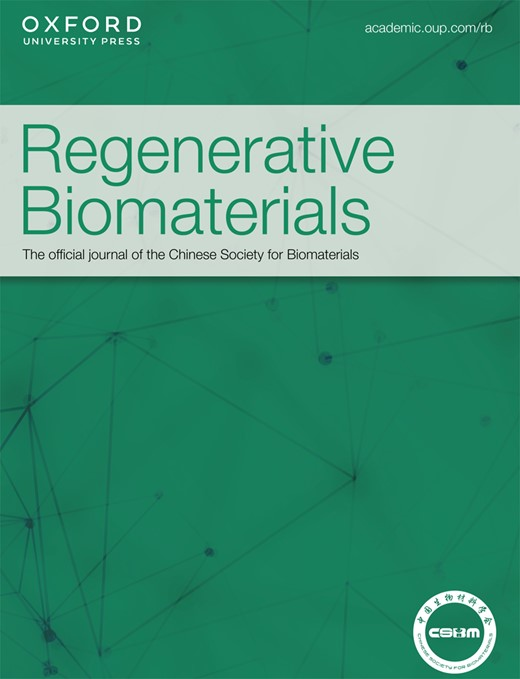Methacrylated gelatin and Platelet-Rich plasma based hydrogels promote regeneration of Critical-Sized bone defects
IF 5.6
1区 医学
Q1 MATERIALS SCIENCE, BIOMATERIALS
引用次数: 0
Abstract
Physiological repair of large-sized bone defects requires instructive scaffolds with appropriate mechanical properties, biocompatibility, biodegradability, vasculogenic ability and osteo-inductivity. The objective of this study was to fabricate in situ injectable hydrogels using platelet rich plasma (PRP)-loaded gelatin methacrylate (GM) and employ them for the regeneration of large-sized bone defects. We performed various biological assays as well as assessed the mechanical properties of GM@PRP hydrogels alongside evaluating the release kinetics of growth factors (GFs) from hydrogels. The GM@PRP hydrogels manifested sufficient mechanical properties to support the filling of the tissue defects. For biofunction assay, the GM@PRP hydrogels significantly improved cell migration and angiogenesis. Especially, transcriptome RNA sequencing of human umbilical vein endothelial cells (HUVECs) and bone marrow derived stem cells (BMSCs) were performed to delineate vascularization and biomineralization abilities of GM@PRP hydrogels. The GM@PRP hydrogels were subcutaneously implanted in rats for up to 4 weeks for preliminary biocompatibility followed by their transplantation into a tibial defect model for up to 8 weeks in rats. Tibial defects treated with GM@PRP hydrogels manifested significant bone regeneration as well as angiogenesis, biomineralization, and collagen deposition. Based on the biocompatibility and biological function of GM@PRP hydrogels, a new strategy is provided for the regenerative repair of large-size bone defects.甲基丙烯酸明胶和富血小板血浆水凝胶促进临界大小骨缺损的再生
大面积骨缺损的生理修复需要具有适当机械性能、生物相容性、生物降解性、血管生成能力和骨诱导性的指导性支架。本研究的目的是利用富血小板血浆(PRP)负载的甲基丙烯酸明胶(GM)制造原位注射水凝胶,并将其用于大面积骨缺损的再生。我们进行了各种生物学实验,并评估了 GM@PRP 水凝胶的机械性能,同时还评估了水凝胶中生长因子(GFs)的释放动力学。结果表明,GM@PRP 水凝胶具有足够的机械性能来支持组织缺损的填充。在生物功能测试中,GM@PRP 水凝胶明显改善了细胞迁移和血管生成。特别是对人脐静脉内皮细胞(HUVECs)和骨髓干细胞(BMSCs)进行了转录组 RNA 测序,以确定 GM@PRP 水凝胶的血管化和生物矿化能力。将 GM@PRP 水凝胶植入大鼠皮下长达 4 周以获得初步的生物相容性,然后将其移植到大鼠胫骨缺损模型中长达 8 周。经 GM@PRP 水凝胶处理的胫骨缺损表现出明显的骨再生、血管生成、生物矿化和胶原沉积。基于 GM@PRP 水凝胶的生物相容性和生物功能,为大尺寸骨缺损的再生修复提供了一种新策略。
本文章由计算机程序翻译,如有差异,请以英文原文为准。
求助全文
约1分钟内获得全文
求助全文
来源期刊

Regenerative Biomaterials
Materials Science-Biomaterials
CiteScore
7.90
自引率
16.40%
发文量
92
审稿时长
10 weeks
期刊介绍:
Regenerative Biomaterials is an international, interdisciplinary, peer-reviewed journal publishing the latest advances in biomaterials and regenerative medicine. The journal provides a forum for the publication of original research papers, reviews, clinical case reports, and commentaries on the topics relevant to the development of advanced regenerative biomaterials concerning novel regenerative technologies and therapeutic approaches for the regeneration and repair of damaged tissues and organs. The interactions of biomaterials with cells and tissue, especially with stem cells, will be of particular focus.
 求助内容:
求助内容: 应助结果提醒方式:
应助结果提醒方式:


